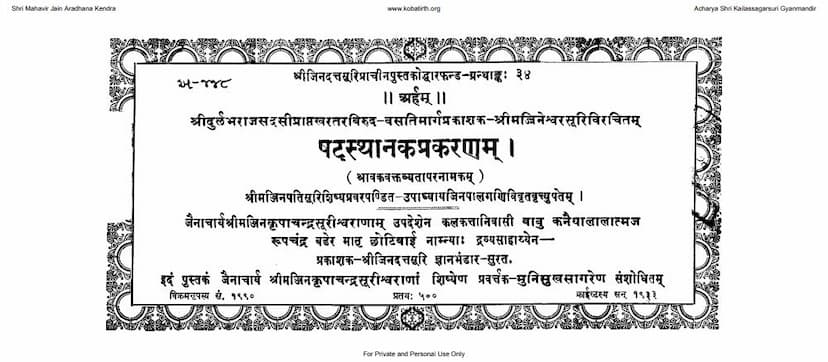Shatsthanak Prakaranam
Added to library: September 2, 2025

Summary
Here's a comprehensive summary of the provided Jain text, the "Shatsthanak Prakaranam" by Jineshvarsuri, based on the provided pages:
Title: Shatsthanak Prakaranam (Six-Place Treatise) Author: Acharya Shri Jineshvarsuri Commentary: By Upadhyay Jinpal Gani, disciple of Jinapatisuri Publisher: Shri Jinduttsuri Gyanbhandar, Surat Year of Publication: Vikram Samvat 1990 (1933 CE)
Overall Purpose and Content:
The "Shatsthanak Prakaranam" is a Jain text authored by Acharya Shri Jineshvarsuri, with a commentary by Jinpal Gani. It is described as being "Shravak Vaktavyata Parma Namak" (primarily concerning the duties and conduct of a layman/householder). The book outlines and explains six essential "places" or qualities that a devout Jain layman should cultivate to achieve spiritual progress and excel in their practice. These six places are foundational aspects of lay Jain spiritual discipline.
Key Figures and Context:
- Acharya Jineshvarsuri: The main author, a prominent Jain scholar and ascetic from the Chandrakula lineage. He was a key figure in establishing the "Khartar Gachh" (a sect within Jainism) and is known for his debates and authoritative scriptural works. The text highlights his historical context, including his association with King Durlabhraj of Gujarat and his role in advocating for the practice of vasati (residing in monasteries or designated living quarters for monks).
- Jinpal Gani: The commentator, a disciple of Jinapatisuri. His commentary elaborates on Jineshvarsuri's verses, providing detailed explanations and context.
- Jinapatisuri: The guru of Jinpal Gani.
- Jinduttsuri Gyanbhandar: The publishing house, dedicated to preserving and disseminating Jain scriptures.
- Babu Rupchand Beder and Shrimati Chotibai: Supporters of the publication, indicating a collaborative effort in bringing this text to light.
The Six Places (Shatsthanak):
The book systematically details six crucial aspects of a layman's spiritual journey. The table of contents provides a clear outline:
- Vrat Parikarmatvam (व्रतपरिकर्मत्वम्): This refers to the cultivation and practice of vows (vratas). It involves understanding, observing, and diligently fulfilling the vows like non-violence (ahimsa), truthfulness (satya), non-stealing (asteya), celibacy/chastity (brahmacharya), and non-possession/non-attachment (aparigraha). This section likely emphasizes the preparatory practices for observing vows.
- Shilavattvam (शीलवत्त्वम्): This pertains to virtuous conduct and good character. It encompasses righteous behavior, adherence to ethical principles, and maintaining purity in one's actions and intentions. It is described as the foundation for true spiritual practice.
- Gunavattvam (गुणवत्त्वम्): This focuses on the cultivation of positive qualities or virtues. It likely includes virtues such as knowledge (gyana), faith (shraddha), patience (kshama), humility (vinaya), contentment (santosha), and detachment (vairagya).
- Riju Vyavaharanam (ऋजुव्यवहारनामकम्): This emphasizes straightforward and honest dealings in all aspects of life, particularly in worldly transactions. It implies integrity, transparency, and avoiding deceit or crookedness in business and personal interactions.
- Guru Shushrusha (गुरुशुश्रूषा): This highlights the importance of serving and respecting one's spiritual preceptors (gurus). It involves attentiveness, obedience, and diligent service to learned and virtuous monks and ascetics, recognizing them as guides on the spiritual path.
- Pravachan Kaushalam (प्रवचनकौशलम्): This refers to proficiency or skill in understanding and propagating the Jain teachings (Pravachan). It suggests an ability to grasp the essence of the scriptures, explain them clearly, and live by their principles.
Historical and Doctrinal Significance:
The preface provides significant historical context about Acharya Jineshvarsuri and the Khartar Gachh. It discusses:
- The Origin of the Khartar Gachh: Jineshvarsuri played a pivotal role in the establishment and recognition of the Khartar Gachh, distinguished by their advocacy for monastic residence (vasati) in designated places, often in opposition to the prevailing "Chaityavasi" (monks residing within temple complexes) tradition of that era.
- Debates and Royal Patronage: Jineshvarsuri engaged in significant debates with Chaityavasis and received the title "Khartar" from King Durlabhraj, signifying his victory and the king's recognition of his pure conduct and teachings.
- Lineage and Succession: The preface traces the lineage of prominent Jain Acharyas, including Vardhamansuri, Jineshvarsuri, Abhaydevsuri, Jinpatisuri, and Jindattsuri, showcasing the continuity of spiritual tradition and scholarship.
- Scriptural Authority: The text emphasizes adherence to the teachings of the Tirthankaras and the authority of scriptures like the Dashavaikalika Sutra. It refutes contrary opinions and practices that deviate from the core principles of Jainism.
Commentary and Elaboration:
The commentary by Jinpal Gani is crucial for understanding the nuances of Jineshvarsuri's verses. The provided text includes detailed verse-by-verse explanations of the initial sections, particularly the first "place" of Vrat Parikarmatvam, breaking down the meaning and significance of each term. The commentary also discusses the sequential ordering of these "places," highlighting their interconnectedness and logical progression in spiritual development.
In essence, the "Shatsthanak Prakaranam" serves as a comprehensive guide for Jain laypeople, outlining a systematic path towards spiritual betterment by cultivating specific virtues and practices, rooted in the authentic teachings of the Tirthankaras and guided by the wisdom of esteemed Acharyas.